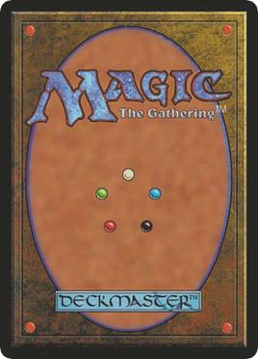 Art by Dan Frazier
Art by Dan FrazierThe Modal Cube was originally designed to include many cards with choices. It quickly became apparent that many of these cards had specific modes that were typically chosen over others, making them less modal in practice than on paper. The cube has evolved over time to focus on cards that create interesting decisions and avoiding vanilla (both in terms of creatures and cards like Lightning Bolt/Counterspell, instead focusing on parallels with interesting added effects).
Major Archtypes


 +1/+1 Counters
+1/+1 Counters


 Aggro
Aggro

 Aristocrats
Aristocrats


 Artifacts, minor in
Artifacts, minor in  and
and 


 Combo, minor in
Combo, minor in 

 Draw
Draw

 Exile
Exile

 Flicker, minor in
Flicker, minor in 

 Rogues
Rogues

 Tokens, minor in
Tokens, minor in 



 Value Pile
Value Pile
Major archtypes are designed to have as much overlap as possible, leading to mid-draft decisions on whether to branch out into synergistic crossover cards or stay in a stricter archtype. For example, Flicker and Tokens have numerous shared cards and both archtypes make use of Bant colours. Aristocrats and Combo both need sacrifice engines, which may be black, red, or colourless.


 +1/+1 Counters
+1/+1 Counters 


The +1/+1 Counters archtype is the iconic midrange deck of the cube. Green provides a strong base of relevant effects, putting counters on either itself, other creatures, or both. Black adds counter-increasing effects and a few key synergies. White adds a few more methods of adding mass or targeted counters and payoffs. This colour trio has one of the few tri-colour gold cards in Ghave, which enables some more potent results with cards such as Herd Baloth, effects like Good-Fortune Unicorn, and counter-increasing effects.


 Aggro
Aggro 


Aggro primarily focuses on inexpensive high-power attackers with a combination of red burn for reach, black or white removal, or ways of removing blockers. It shares many pieces with Aristocrats in recursive threats, Tokens to get extra value while maintaining pressure, and many cards have arch-type specific purposes for other decks that meet aggro's need for dealing with blockers or hitting face. Although supported in three colours, aggro decks are typically one or two colours.

 Aristocrats
Aristocrats 

Aristocrats uses the typical sacrifice engines with life-drain effects. It leans heavier on its Black effects, with choices between recursive creatures or token producers. It also borrows from Red's aggressive creatures and burn to reduce the total drain necessary to close the game out, but also adds some incidental tokens. It also has crossover with the Combo decks who would use the sacrifice engines to go infinite, and likely fight over colourless card effects.




 Artifacts
Artifacts 




The Artifact arch-type primarily functions off of artifact token producers for fun and profit. Artifact decks can potentially be fairly aggressive decks that create incidental value, which it can use to press the attack or continue to cast spells while discarding lands. The other option for Artifact decks is a long-term grind, creating a critical mass of tokens that it can use to control the game. In both cases, the tokens can build towards an excessively large creature that breaks board stalls itself or attaches to something evasive, or animating noncreature artifacts to get bonus value.
In contrast to a primarily 

 build, a
build, a 
 Artifact Deck primarily relies on token doubling effects and various Artifact token producing effects.
Artifact Deck primarily relies on token doubling effects and various Artifact token producing effects.
While not intentionally supported in  , there are some incidental token synergies, while Red removal can help a slower Artifact deck buy time to reach the late-game.
, there are some incidental token synergies, while Red removal can help a slower Artifact deck buy time to reach the late-game.



 Combo
Combo 



The primary supported combo in the cube is a Persist-based sacrifice engine. The deck uses one of several effects to prevent a Persist Creature from keeping its -1/-1 counter, sacrificing it repeatedly to end the game. Combo usually prioritizes tutors and ways of recovering dead combo pieces. The deck fits within either a midrange shell playing with a back-up win condition or as an all-in combo deck running 3+ colours.
Devoted Druid is also supported, with ways of generating infinite mana. There are only a couple ways of winning the game immediately with mana alone, so it can also just provide the ability to empty your hand, pairing well with card advantage effects, or infinite flicker.

 Draw
Draw 

The Draw arch-type focuses on triggering effects on the second card drawn per turn, with incidental benefits of discarding cards. Many of the cheap, repeatable cards that fuel this arch-type are looters, which interacts with both draw and discard. There are a few engines that are largely independent of one another, either generating a token army, controlling the board with free burn, making a large attacker, or milling the opponent. Draw decks can play as either aggressive or controlling, depending on match-up and which payoff resolves. The unblockable looters and tokens often pair well with an equipment sub-theme.

 Exile
Exile 

The Exile deck focuses on consistently generating value each turn. It has access to several cards that allow it to play the top card of the deck, in addition to cards that exile themselves or others. The arch-type utilizes a wide array of mechanics that exile, including Rebound, Madness, Foretell, Adventure, and Cascade. Its three major payoffs generate additional value in tokens, cascade, or direct damage plus the potential for an undercosted board-wipe, but the deck also sees general value in overall card advantage.
With all of its filtering and recasting potential, Exile benefits from seeing the top card, which lets the deck manipulate draws and exile effects while avoiding dead draws. It often relies on mana acceleration to fuel its value engine.
Because the deck often discards cards, it competes with 
 Draw to draft discard synergies.
Draw to draft discard synergies.


 Flicker
Flicker 


The Flicker arch-type comes in several categories, but all rely on single use or repeated triggers of exiling a permanent and returning it for value. It generally focuses on triggered abilities when permanents enter the battlefield. Most effects work with creatures, but Teleportation Circle and Brago, King Eternal can flicker non-creatures, including artifact triggers or resetting permanents that use counters.
Flicker decks have access to two types of locks. The first involves attacking the opponent's permanents, preventing them from establishing a board presence, potentially splashing  for redundancy. The second involves flickering Eternal Witness to re-cast Time Warp for infinite turns.
for redundancy. The second involves flickering Eternal Witness to re-cast Time Warp for infinite turns.
In addition to the above uses, Flicker decks may be tempted to use  for additional effects. This may blur the lines between Flicker and Tokens, as more mana-intensive decks may flicker Astral Dragon to make increasing copies of Parallel Lives.
for additional effects. This may blur the lines between Flicker and Tokens, as more mana-intensive decks may flicker Astral Dragon to make increasing copies of Parallel Lives.
Flicker can potentially also find synergies in  and
and  , but this isn't a specifically designed interaction within the cube.
, but this isn't a specifically designed interaction within the cube.

 Rogues
Rogues 

The Rogue deck relies on Rogue cards that are used to support both the 
 Draw deck and the
Draw deck and the  X Artifact deck, using a few key tribal buffs with naturally evasive creatures. It is an aggressive deck that benefits from the counter magic in
X Artifact deck, using a few key tribal buffs with naturally evasive creatures. It is an aggressive deck that benefits from the counter magic in  and the removal in
and the removal in  .
.


 Tokens
Tokens 


The Tokens arch-type uses doubling effects to get extra value out of cards that produce token creatures, clues, food, treasure, or others. The deck often leans heavier into  , where it can benefit from a devastating top end, but
, where it can benefit from a devastating top end, but  has some pay-offs for using excess mana as well as adding consistency.
has some pay-offs for using excess mana as well as adding consistency.
Tokens may also be 

 , using the
, using the  token producers, mass buffs, or miscellaneous synergies. It may also lean heavily into the artifact token producers and draw on artifact pay-off effects.
token producers, mass buffs, or miscellaneous synergies. It may also lean heavily into the artifact token producers and draw on artifact pay-off effects.



 Value Pile
Value Pile 



The Value Pile arch-type uses various recursion effects to build engines of incremental advantage. These may involve sacrificing for value and then recasting the creature for further benefit, repeated removal, or build-your-own Vindicates. Because this arch-type is often tempted to pick fixing highly, it may have cause to add some five colour options.

